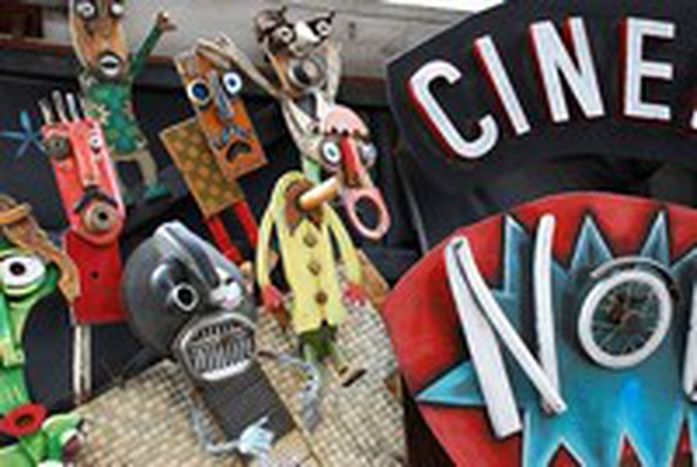
Cinema: Europe up to your eyeballs
Published on
Translation by:
 claire hooper
claire hooper
The best European film of the last 50 years, set against the backdrop of Europe's first 50 years
In 1957, six major international actors showcased the preview of their first work with the Treaty of Rome. But no one suspected that this feature-length film of a new genre would become the most improbable co-production in history. The European public, whose hearts and households were only just beginning to heal after the Second World War, was present at the screening.
The icon of this decadent period is Antonio Ricci, the unlucky bicycle thief who pilfers scraps of food in 1948 Italy, in the film of the same name (Bicycle thieves or El ladrón de bicicletas, Vittorio De Sica). Difficult times brilliantly portrayed by the masters of what we might call Italian ‘neo-realism’: directors Pier Paolo Pasolini, Luchino Visconti or Michelangelo Antonioni.
Alienation, death, social crisis. The Italians, like the Germans, the Belgians, the Dutch, the French and the Luxemburgers took some time to come round to it. Perhaps they all had something for the heroine of ‘
’ (1952) by Roberto Rossellini. Irène Girad, a despairing young foreigner played by Ingrid Bergman, attempts to redeem herself after her fashionable son’s suicide by devoting her fortune to relieve poverty.
Europe 51
Renewal was difficult. The ground may have been fertile, but the shadow of the hammer and sickle did not reap a good harvest. Villar del Río, a little Castilian village, was the first to greet the Americans with their Marshall Plan of 1947, aimed at rebuilding Europe, in Welcome Mr. Marshall (Bienvenido Mister Marshall, 1952). Spanish director José Luis Garcia Berlanga filmed this little Castilian village with scathing irony, spicing up the Spanish isolation under dictator Francisco Franco in 1953.
The script falls through
The Marshall plan crossed Spain and Portugal without leaving a mark, but had its effect on reaching the rest of Europe. The common market started to operate. Customs barriers between the states were abolished. It was the crazy time of the sixties. In front of the cameras, Swedish actress Anita Ekberg goes for a swim with Marcello Mastroianni in the Trevi Fountain, in larger-than-life Italian master Federico Fellini's The Sweet Life (La Dolce Vita, 1960).
A year later, in the French hit Jules and Jim (Jules et Jim, 1961), we watch Catherine being chased through the streets of Paris. Though the story immortalised by 'New Wave' (la Nouvelle Vague) director François Truffaut was supposed to have been set at the beginning of the century, it reflected the happiness that was intoxicating France during the booming 'Thirty Glorious Ones' (Trente Glorieuses), after World War II. The scent of freedom was drifting across the rest of democratic Europe.
'New Wave' cinema dreamt up a new way of examining the changing behaviour of the Europeans, with masterpieces from French-Swiss Jean-Luc Godard and Frenchman Éric Rohmer.
France's month of revolution came in the May '68 barricades, along with a A Piece of Pleasure (Une Partie de Plaiser, 1975) by French director Claude Chabrol. But on the other side of the Iron Curtain in an icy corner of Berlin (which became a life-size film studio), The Spy Who Came In From The Cold (Martin Ritt, 1965), did his best to avert the Russians and Americans from silently destroying one another in order to rule the world. Based on an espionage novel, the vehicle starred Richard Burton.
Key onscreen images correspond to Europe's Jews, who gave their perception of the Cold War by moving on - think the red telephone that ‘Doctor Strangelove’ refuses to answer in Stanley Kubrick’s 1963 Dr. Strangelove, or How I Learned to Stop Worrying and Love the Bomb. Or the exposure of a KGB spy in Topaz (1969), one of Alfred Hitchcock’s first feature films. This espionage wave was followed by the exile of many masters of cinematography: Billy Wilder, Luis Buñuel, Ernst Lubitsch - not forgetting the infamous booting-out of Roman Polanski.
A winner of a film
When an enthusiastic public asked even more of Europe, three new players joined the cast: Great Britain, Ireland and Denmark. The Portuguese drew attention to themselves by throwing flowers (during the Carnation Revolution). Spain's Franco died soon after, from a fit of hysteria which may have been provoked by the young agitator Pedro Almodóvar, dressed as a woman during the non-stop fiesta or ‘Movida’, which prevailed in Madrid at this time. With his first opus, Pepi, Luci, Bom and Other Girls Like Mom (Pepi, Luci, Bomb y otras chicas del montón, 1980), which depicted many of his friends, Almodóvar shone the spotlights on the reality of a whole generation of post-Franco Spaniards. They were determined to swallow Europe whole, and began by consuming themselves.
The twilight of the seventies resembled the script of To Begin Again (Volver a empezar, 1982) by José Luis Garci. If a certain kind of Spain was dying, another was coming to life, like a breath of fresh air after years of being sentenced to the church and the altar. Directors Victor Erice, José Luis Garci and actor Javier Bardem are protagonists of this wave.
Then along came the stifling eighties, with the arrival of Greece, Spain and Portugal in the camera crew. The Iron Curtain fell, letting the other half of Europe say Good Bye Lenin!’ (2003), in the much later film by Wolfgang Becker. Andrzej Wajda's Man of Ironendeavoured to bring to light the Polish dissident and symbol of ‘Solidarnosc’, Lech Wasa, who also wanted a seat on the first row of the orchestra.
The satirical tract, the USSR and the gulag were becoming extinct. History was becoming more and more complicated. Directors Wolker Schlöndorff, Wojciech Marczewski and Oscar-nominated Krzysztof Kieslowski had understood that well.
And when finally we thought the sun had come out to shine again, storm broke out across the European continent. During the nineties, the ghost of the war came back to haunt Europe. New protagonists were becoming active in the Balkans, thrust into the main roles by the 1992 Maastricht Treaty. Amsterdam, Austria, Sweden and Finland came onstage.
Refugees, NATO, destruction. Words belonging to a violent dialogue. Bloody scenes onscreen. No Man's Land (2001) filmed by Bosnian director Danis Tanovi responds to the nostalgia of the men with no country who were immortalised in Underground (1995) by Sarajevo-born Emir Kusturica. Men among men, brothers who confront each other. Fade to black.
Happy ending
 Alas, the conflict in the former Yugoslavia and the Danish director Lars Von Trier brought out The Idiots (1998) we all are, at heart. Everyone realised that there was lots to be invented and the avant-garde cinematographic movement Dogma 95 was much more than the Ten Commandments of cinematographic norms.
Alas, the conflict in the former Yugoslavia and the Danish director Lars Von Trier brought out The Idiots (1998) we all are, at heart. Everyone realised that there was lots to be invented and the avant-garde cinematographic movement Dogma 95 was much more than the Ten Commandments of cinematographic norms.
It was a way of saying ‘no’ to what is taken for granted, to what is imposed on us, as the image of the French and the Dutch during the 2005 referendum on the European Constitution. Yes, we have to learn to live together in a 'Spanish apartment' as rendered by Cédric Klapisch in Pot Luck (L'Auberge espagnole, 2002) - we are all equal, we are also all different.
Twelve new countries entered the European Union in 2004, preceeded by the infectious joy of French heroine Amélie (Le Fabuleux Destin d'Amélie Poulain, Jean-Pierre Jeunet, 2001). As 2002 gave birth to the Euro, hope remains on the horizon with a new generation of European directors, including the 'Italian Woody Allen' Nanni Moretti and Alejandro Amenábar (Penelope Cruz-starring Open Your Eyes, Nicole Kidman flick The Others and the Javier Bardem vehicle Sea Inside.)
Thus ends the first part of the film. No final applause. No credits. But a second opus is already being filmed with new actors, even unknown entities, with a new script that is in the process of being written. One thing is for sure. When the fourth movement of Beethoven’s ninth symphony rings out, we’ll know which film it is.
Top ten European films as voted for by cafebabel.com
Amélie (Le Fabuleux Destin d´Amélie Poulain, 2001), Jean Pierre Jeunet
Cinema Paradiso (Nuovo Cinema Paradiso, 1988), Giuseppe Tornatore
The 400 Blows (Les quatre cents coups, 1959), François Truffaut
8½ (2 Oscars - best foreign language film, best costume design, 1963), Federico Fellini
Talk to her (Hable con ella, 2002), Pedro Almodóvar
Black cat, white cat (Crna macka, beli macor, 1998), Emir Kusturica
Breaking the waves (1996), Lars Von Trier
Breathless (À Bout de Souffle, 1960), Jean Luc Godard
The Life of Brian (1979), Monty Python
The Spirit of the Beehive (El Espíritu de la Colmena, 1973), Víctor Erice
These films have been selected in a poll drawn from cafebabel.com's extensive network of writers, translators and local teams across Europe
Translated from Luces, cámara… ¡EUROPA!


